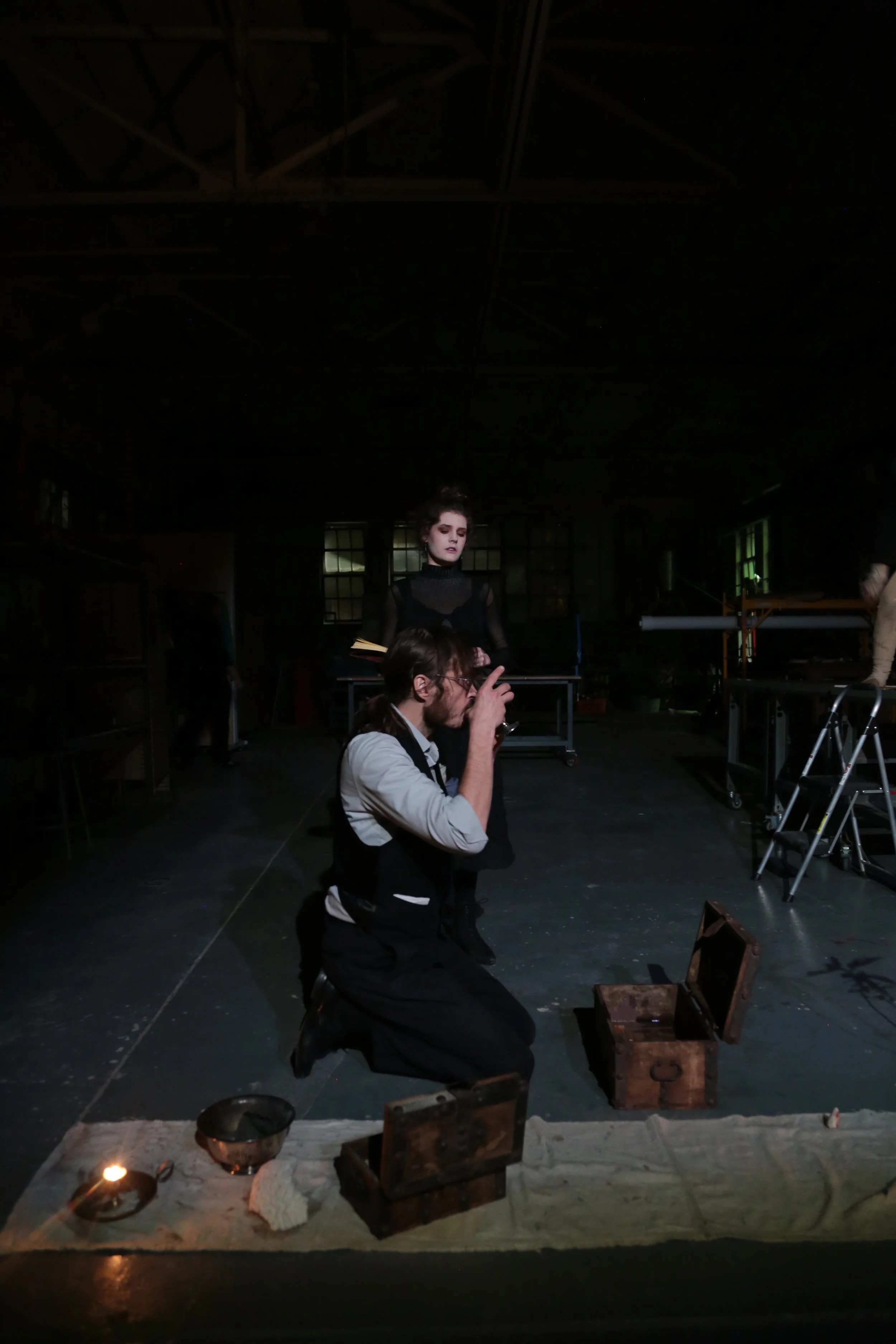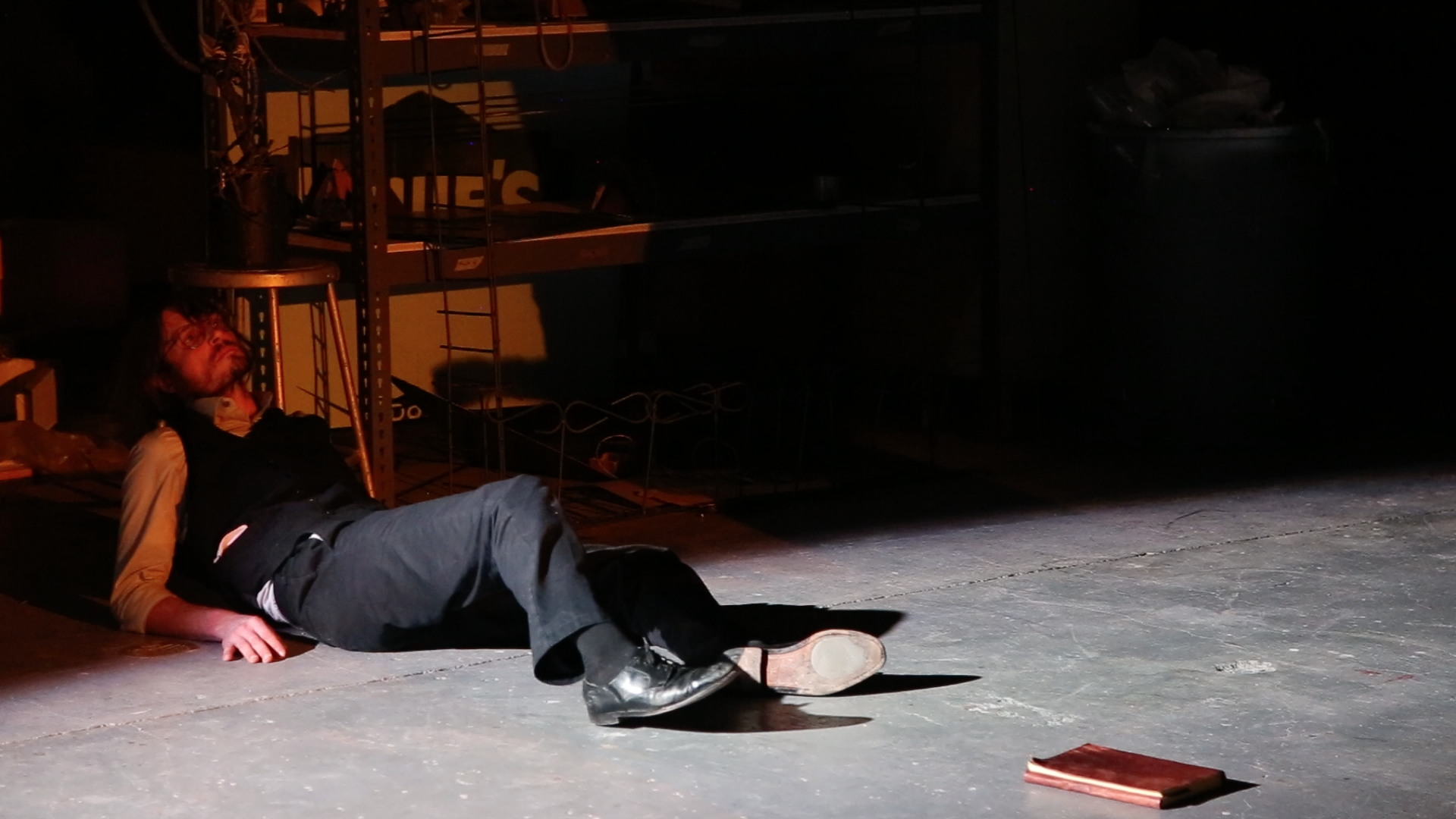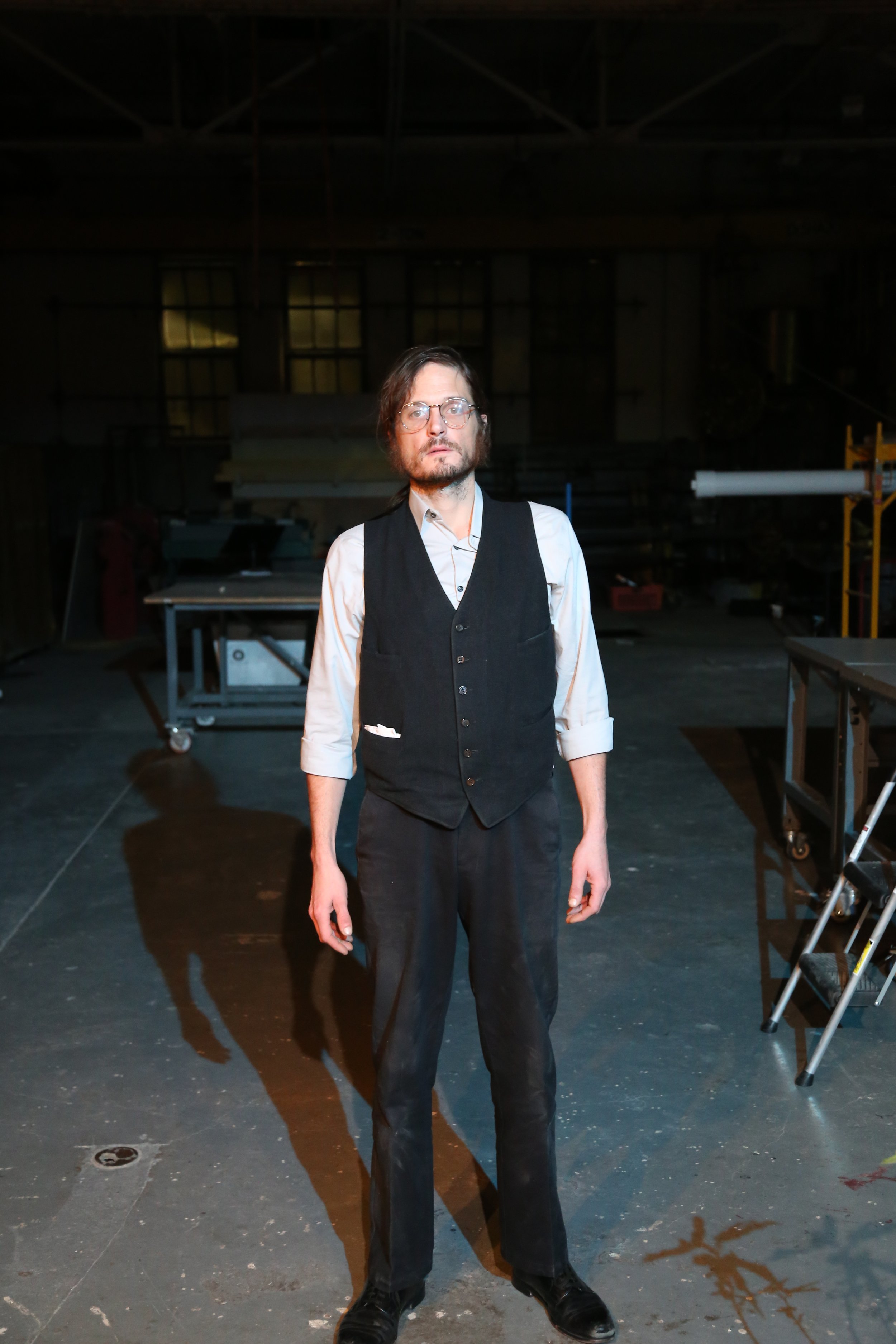
FRANKENSTEIN
Fall of 2018. An adaptation of Frankenstein developed across a year. Working Title: The Nameless.
I worked in rehearsals with a group of four -- two young actors, a dancer, and a gardener -- for 3 months along with a composer. When we presented our work over the course of 6 nights, we were still only scratching the surface of all that we'd begun exploring and ended up with more exciting ideas than we'd started with.
I'd been obsessed with the Newcomb Sculpture building, Woldenberg, and I'd wanted to make a piece there that could incorporate the energy of a creative laboratory where artists brought ideas into physical form. I thought, I want a Welder to hammer throughout a play and watch them make a sculpture, and my next thought was it has to be Frankenstein. I'd never read the book but was in awe that Mary Shelley finished writing it when she was 19 -- the book creation itself entered a realm of magic and dreamweaving and mythmaking. I soon discovered how rich the text itself was - how beautiful the Creature's discovery of nature and how horrible that of the people of the world - the unnamed Creature's plight is relevant to anyone who's been abandoned by their community or their kin and their articulation of their circumstances parallel in an uncanny way some writings of Frederick Douglass. I also wondered about Frankenstein as a creator - his decision to bring something into the world and refuse to take responsibility for its consequences.
Ultimately it was a catalyst to work with others. We experimented endlessly. The group was incredibly willing to try out any strange method that may result in something real or true that we could use. You can see from these photos that the piece was dark and intense and scary and beautiful. I'm grateful to have gone on the journey of making this piece with others. I'm glad I made it back then because my desire now is to make something joyful and exuberant and full of light, but there is a time and season for all things, and though the darkness is unpleasant it's often where one must go to pass through and find where the real medicine is.



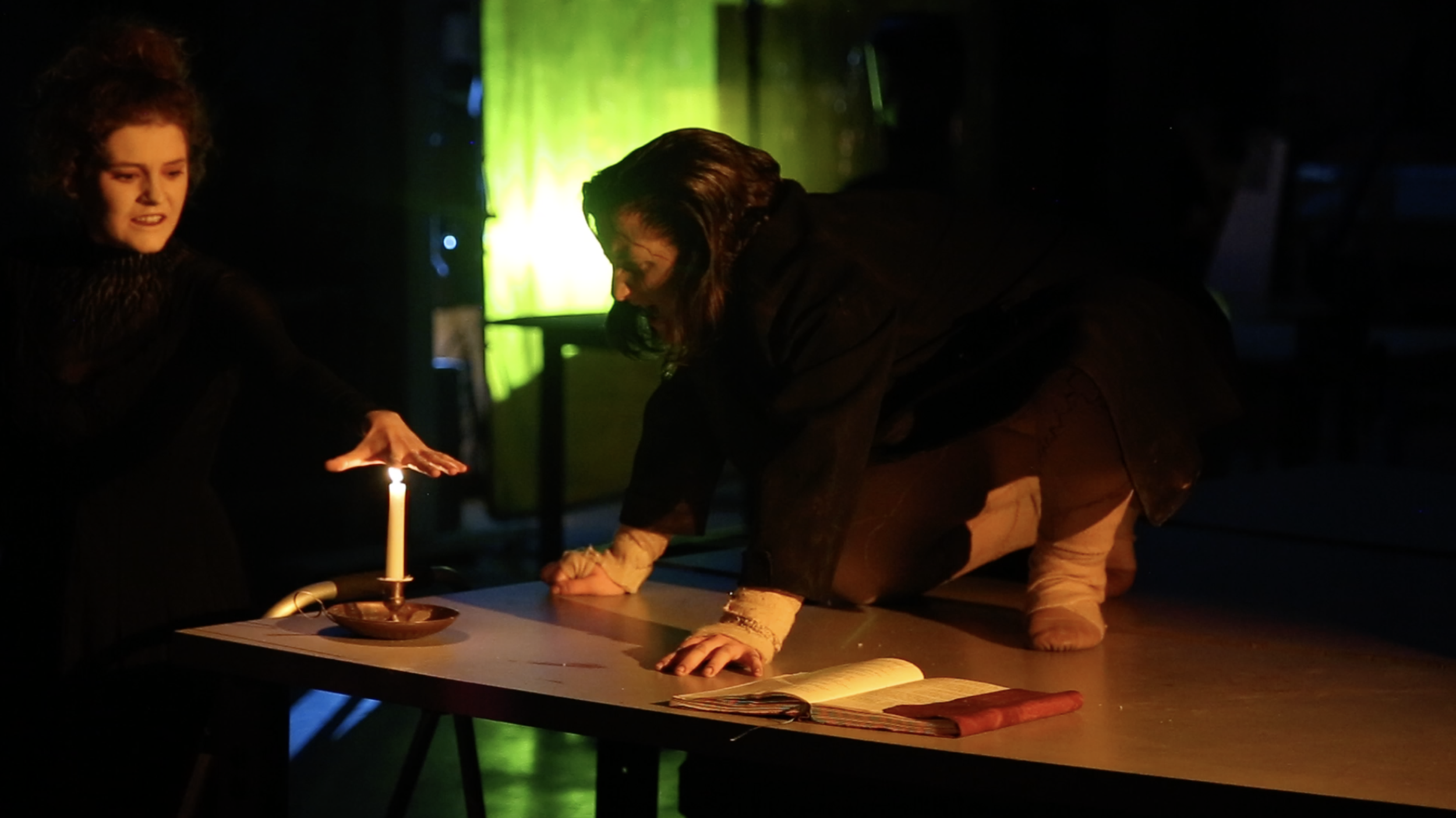
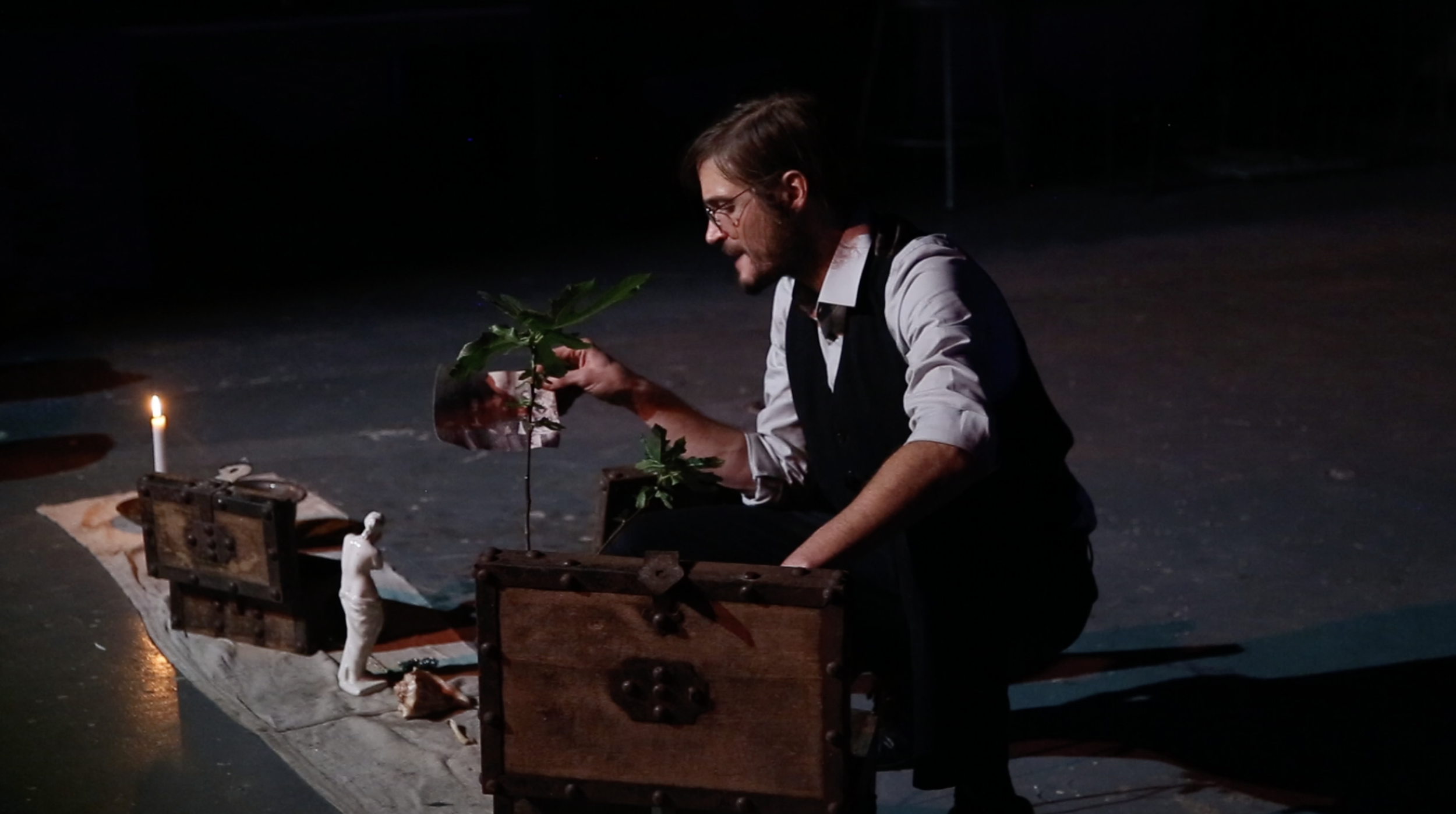








BRIEF SUMMARY
A young brilliant scientist constructs a creature of repulsive physical aspect but sound mind out of the organs and limbs of dead bodies. The ancient curse of those who imitate the Creator will be struck down. When Frankenstein finally brings his creature to life he is horrified by what he’s done and flees. He receives a letter from his father that his younger brother William was strangled to death. A medallion worn by William is found in the pocket of a young girl, Justine, and she is hung on the gallows. Shocked by these events, Frankenstein wanders into the valley of Mont Blanc where a figure moving rapidly over the ice charges towards him. It is the creature and he’s built a hut in this desolate landscape. He recounts his journey to this point to Frankenstein—from the laboratory to his discovery of sensations and first contact with people, a brief glimpse at happiness with a country family where he learns language and is later thrown out. He rescues a drowning girl and is repaid by being fired at. Knowing nothing else he set off toward Frankenstein’s home country, kills William and frames Justine in an act of revenge against humanity. He demands that Frankenstein give him a companion because he aspires to happiness and Victory accepts the task with the condition that the couple live away from civilization forever. He then departs for Scotland where he all but completes the work before destroying it in rage. The creature arrives to discover the scene and promises to see Victor on his wedding day. Victor returns to marry the orphan girl he grew up with and on the evening of their wedding discovers her dead in there bed. Victor resolves to destroy the creature and pursues him to the far north but is beset by exhaustion and rescued by a boat heading on an expedition to the North Pole. After relaying the story to the captain, Victor dies on board. He’s discovered with the creature leaning over his corpse. Overwhelmed with despair, the creature announces that he now plans to burn himself alive on a pyre which he himself will build. In the final pages he is seen by the crew drifting away on a block of ice.
CREDITS
a new piece based on Mary W. Shelley’s Frankenstein
with direction by Christopher Givens
and an original score by Jeffrey Pagano
October 26th thru 31st, 2018. 9:00PM
Newcomb Sculpture Studio
cast
Greg Marzo, Captain Robert Walton
Hailey Mozzachio, the creature
Drew Pearson, Mary Wollstonecraft Shelley
Kyle Washam, Victor Frankenstein
Rose Doucet as herself
musicians
Hannah Ulatowski, violin
Jeff Pagano, electronics
Kelsey Kroening, piano
designers
Naomi Detre, costumes
Jasmine Williams, lights
Rachel Yura, makeup
Lianna Mae Smith, run crew
This piece was conceived and adapted by Christopher Givens with immense support from the ensemble, friends, family, colleagues and collaborators including
Mathilde Pellegrini, Anne Howard, Timothy Adams, and Ann Glaviano.
Special Thanks to Amy Chaffee, Adam Crosson, Vlad Ghinea, Jenn Jacobs, Sadie Sheldon, Joshua Stover, Stacy Hoover, Barbara Hayley, Michael Batt, Bryan Gottshall, Myrna Padilla, Betsy Primes, Jordan Phillips, Claire Givens, Aaron Sarles, Johnny Glass, Blas Isasi, Kaylen Kline, Joshua Edward Bennett and many more.
Sample of text materials for The Nameless:
Play Proposal: Mary Shelley’s classic tale of tragic horror brought to life in the unique setting of Tulane’s Woldenberg Art Center, home of the Newcomb Sculpture Department. In a collaboration between students of acting and sculpture, a new version of Frankenstein will be devised that takes advantage of the unique facilities at Woldenberg as well as it’s students contributions to key aspects of the story through prop, set design, and choreographed dramatic moments that utilizes the foundry equipment. Our creation process will revolve around the key moments in Shelley’s novel, with a keen eye to their contemporary relevance. Using as reference the stage adaptations of Victor Gialanella and Nick Dear respectively, as well as the graphic novel by Bernie Wrightson and the devised 1965 version by The Living Theatre, our production of “The Modern Prometheus” will aim to distill the terrifying essence of the original while conveying the continued relevance of it’s questions concerning scientific experimentation, creative responsibility, the nature of the mind and the borders between good and evil.
A set will be conceived of that can fit within Woldenberg that is able to represent a handful of places, primarily Frankenstein’s Laboratory and Chateau as well as a Cottage and Graveyard. Digital projections could be used to potential effect as well as practical tools from the sculpture department such as welders and metal forges.
Props and Sculptures: Working with assistant professor of sculpture Adam Crosson and his students, we will fabricate key props in the story as well as other created objects and set pieces that contribute to the unique world of our play. The production will take place in the foundry at night during shop hours during which sculpture students will be allowed to work on their pieces for class. Their assignments during this period may relate to the play thematically but it is the fact of their presence as creators that will create an atmosphere or background against which our play unfolds.
Along with these sculpture students a second set of students will perform actions of fabrication the tie directly to the play. These students will be enrolled in an independent study class taught by Asst. Professor Crosson and will act as ‘featured extras’ who build and interact with a series of sculptures that are created collaboratively with the production team. By dividing the action of the story into 8 sections, each episode will have an artwork correlating to its themes or setting. These 8 episodes would be spread out inside of the foundry in various zones of action.
Lighting, projections, sound: Practical lights will be used, as well as lights integrated into the set design itself. Other lights can be hung from the foundry’s ceiling beams using the sculpture dept.’s ladder or mobile scaffold.
MARY WOLFSTONECRAFT GODWIN SHELLEY
motherless child
dragging out our buried fears and apprehensions into the open to help us face and understand them
Dr. FRANKENSTEIN
motives: the world must be changed, a new man must evolve to a higher level, all human suffering must be eliminated
initially seeks to discover the source of nature, the seed.
-passionate curiosity about the mysteries of life
-The world must be changed, a new man must evolve, and all human suffering must be eliminated
-then seeks to ‘correct’ death and in so doing refuses life
attempts to imitate ‘The Creator’
does he sincerely desire to do good? is he driven by desire for personal achievement?
refuses to affirm man as he is: inherently flawed and maybe evil but perfectible
-his actions come from a sincere desire to do good, yet he creates evil against his own wishes. he seeks solutions where there are none. he should have started with what is—the living not the dead. his refusal to believe in man as he is—evil but perfectable—is VF’s sin
THE CREATURE
physically repulsive, but mentally sound
an assemblage constructed piecemeal from the organs of dead bodies—pieces from the death houses and cemeteries—perhaps a criminal or a priest, man or woman, one with money one without, a devil or a saint
eloquent but sad, searching for knowledge, acceptance, humanity, love, and a mate. we hear his thoughts, feel his pain
he becomes what he is through the knowledge and experience he gains from Dr. Frankenstein and the world that surrounds him.
excess of existence, exceeding representation, and hence appearing to others as a chaotic spillage from his own representational shell
the monster/thing is even more ourselves than we are—our own inaccessible kernel, and Otherness which directly IS ourselves, staging the phantasmic core of our being. a materialization from inner space. an encounter with it brings is too close to that which, though it lies within us, we must remain at a distance if we wish to participate in everyday life. brought face-to-face with an idea of the infinite
“If there is scenery, the space is not empty, and the mind of the spectator is already furnished. A naked area does not tell a story, so each spectator’s imagination, attention and thought process is free and unfettered.
Emptiness in the theatre allows the imagination to fill the gaps. Paradoxically, the less one gives the imagination, the happier it is, because it is a muscle that enjoys playing games.”
-Peter Brook, The Open Door
(Fritz Lang’s Metropolis, Charlie Chaplin’s Modern Times, Blade Runner?)
moveable panels / flats to create walls and doorways and various angle
attributes “Oneirodynia” - waking while in a dream
separation of the mind and body which could occur during sleep
is it possible not to lose hope? to maintain aggressiveness
primary enemy: stagnation of imagination
secondary enemy: self-delusion
CENTRAL IMAGE
Forest of the mind (sculpture studio)
La Lune / The Moon: Cosmic mother, womanhood, deep intuition, dream, the subconscious, illusions, solitude, night, sadness, stagnation, gestation, desire to return to the womb, madness, superstition, depression, secret, concealment, that which is hidden
DRIVING ACTION
How do we live with a mature understanding of our impermanent egos. How do we live in freedom and with love?
By the end the characters all disappear, leaving only the environment and swirl of sound and voice, the audience now sees in the darkness of the space a new vision and reactivated imagination. on a high they are encouraged to explore the courtyard space where art functions in symbiosis with the performance.
Watch:
Wooster group : House / Lights
Tadeusz Kantor (Mary, ever present writer, dircetor, dreamer, keeper of memory)
Coppola: Live Cinema and its Techniques
RESEARCH
theatrical inspirations: Master by Foundry Theatre, The Encounter by Complicite
Coleridge Phantom Ship
ADAM
-what constraints should we work with?
-what limitations set to
ACTORS
an exercise in fearlessness - ‘the true process of construction involves at the same time a sort of demolition.’
erase from your minds the idea that this is a play or theatre or any other category previously established. we are going to work on something together without worrying about what it is called. after we finish and the process has been completed then we can name it. in regards to fear, we will strive to be conscious of it when it arises in us and observe how we set up our own defenses. in creating this piece, security is not something we will bother with having a permanent grasp of. in this way we’ll be allowed to experiment with one another to find a way of working that truly taps into each of our own creativity. The small spark which began this project and which hopefully excited each of you will be the primary goal, the flame we want to keep lit every rehearsal. In our preparation we will take risks and support our fellow cast in experimentation without judgment—any choice
Outline:
Prologue MARY ’S DREAM she drinks from the well 5 mins
- the story of Prometheus
the story of the storm at Lake Geneva and the ‘ghost story’
her divine moment of inspiration / Mary’s Waking Dream
Movement 1 WALTON’S LETTERS 9 mins
-The Expedition “something at work in my soul: a love for the marvelous”
stiff gales, navigating, ecstasy on the waves
-Discovery of Frankenstein on Ice
-Comrades in Ambition, intimate conversation in the cabin
Movement 2 FRANKENSTEIN’S STORY 15 mins
-A Charmed Childhood / Science & The Mysteries of Nature
-The Lightning Tree, eruption from clouds & The Delirium of Obsession
-Experimentation “to hear the song of the earth”
-the assembling: bound and stitched
-starting a fire: The Horror of Rejection
sparks from the saw and welder: animation, electricity
-Victor’s dream: a fear of death / longing for his dead mother
Movement 3 THE CREATURE 19 mins
- violent birth & banishment. escape into sunlight. his exile
- grace: the discovery of nature & innocence / in the garden
Discovers the forest. the peace of wilderness, nature’s cycles, sensations arise
it dreams: the Lab, the Mob, the Wild, dreams like no other being’s..Jung’s red book?
- examples of tenderness, learning, history
- reflection: the thing with no name
- creature’s last risk & rejection
- Revenge: burning the cottage
Movement 4 WALTON FRANKENSTEIN CREATURE 11 mins
- Request of a beloved: “Make me happy or I’ll have my revenge”
- Victor’s dream (Henry’s eyes) — the bride is destroyed
- wrath and revenge
- on the ice, the two pursue each other, who chases who?
Movement 5 THE ICE FIELD 10 mins
- pained farewell
- what the creature never has: fulfilled desire for total affirmation of life
or an all loving parent
- discovery of the world as it is, all things return to the source
- the Creature is last seen walking across the frozen landscape
Thematic Prompts
scientific experimentation, creative responsibility, the nature of the mind and the borders between good and evil.
the sublime
memory & death
the outsider, the low rank
what it means to be human / to live with technology
-to understand any complexity in its simplest form
-all diverse fields are in some way similar
=break open the barriers of different disciplines or arts
=find the common language between them
+connecting links
thunder, lightning, fire
decomposition, decay
systems built to fail
alchemy and magic
working of the imagination
attaining Godlike power, defying God/life/nature/laws
uncovering the ‘secrets of heaven’ / ‘secrets of the world’
how a passion for discovery, creation, and exploration can lead to isolation
-perhaps the closer one gets to a rare unique achievement, an extreme, the further
they move from intimate loving relationships
life after death
rebellion against status quo
The world must be changed, a new man must evolve, and all human suffering must be eliminated
electricity
awakening of consciousness
necessity of risk/failure in forging new paths
belief in value of creativity/play/experimentation/imagination
rhizomic structure (the creature and the sum of its parts)
nature vs nurture (‘you gave me the emotions yet told me nothing of how to live with them)
the first cause of life
the end of human suffering
reversing the flow of energy
reanimating something dead (‘can one reanimate something that’s dead?’)
-passion, programs, systems, talents, ideals, muscles, relationships
combatting lose, acceptance, against surrender, battling reality,
desire to control life when life happens beyond control
harmony / disharmony
seeking solutions to a problem that is meant to be
THEMES
how can we end human suffering?
what makes a man
what is the animating force of nature
how do we face an absurd condition
what do we want the audience to leave with?
PROPS
Candle holders and candles
Notebooks
splattered in blood and shit ‘tortured the living animal to animate the lifeless clay’
‘workshop of filthy creation’
Letters (Walton’s)
PROJECTIONS
drone to document / broadcast
child in sand finding his senses
FACES OF THE CREATURE: the rejects of society, the alts in Nola/Tulane
Slaughtered meat
chained to a tree
Abbie Hoffman - ‘the gears of the machinery’
how much of our lives is predetermined by the forces which created us and how much is in our own hands? the question of fate and freedom is central to mary shelley’s novel and guided the process of bringing this adaptation to life.
the impossible task of artificially creating an ideal body
defying the limits set by nature
“monster, an ambitious individual breaking the laws of nature and society by assuming the role of a god-like creator”
on a collision course to be reunited. both have become monsters
his strongest desire is to love and be loved and yet his appearance only ever provokes horror and disgust. It has nothing to hold on to, no hope for acceptance or affirmation from anything other than silent Nature. This constant rejection of the outcast leads to anger and hope of finding solace in revenge. (“So much for benevolence, I’ll have my revenge”) He tracks down his creator (Make me happy and I shall again be virtuous), slowly kills his entire family and then chases Victor (or does Victor chase him?) onto the barren ice of the North Pole.
Victor says to himself “If you never admit you did anything wrong and you hope that they can never prove that you did”
at times actors roam on stage—whether it is the author Mary who can move freely from her writing table, to taking up a brief costume and being in a scene as ‘Mother’ or ‘Elizabeth’. Victor also moves back and forth: from telling his story to Walton in the chamber of the ship, watching a scene play out which he is describing, to leaving the chamber and walking into a scene himself. the movement is fluid. there are sometimes doubles for characters who tell their story and watch as another actor plays their part.
Sculpture shop:
LABORATORY SPACETIME
to weave together narratives told through the characters in the novel, while opening up the show to other dreamscapes as well. becoming itself a assembled creation that carries multiple creations within it
for the fiction to shatter so that events can arise from anywhere.
Episode 1 Awakening of Play and Desire
a. Elizabeth the beloved
b. Passion for science and discovery, curiosity about the mysteries of life
c. memory of the lightning struck tree, eruption from the clouds
Episode 2 Isolation and Failure, Experimentation “to hear the song of the earth”
a. embraces mystical ideas of science and medicine, dreams of man as he would like him to be, free from the burden of biological limits
b. theorizes a leap into freedom from decay. unlimited strength. delirium of achievement.
c. A miracle
Episode 3 Lightning, Animation, Phantasmagoria
a. Igniting life force into the lifeless— Do the bodies come for any particular place?
b. Separation—Frankenstein flees in horror, Creature escapes the lab into sunlight
Episode 4 Awakening of Hate, Sense, Beauty, and Betrayal
a. Outcast from society, Creature learns hate, disgust, anger and violence of society
migrates to the fringe of the fringe
b. Discovers the forest. the peace of wilderness, nature’s cycles, sensations arise
c. He dreams: the Lab, the Mob, the Wild, dreams like no other being’s..Jung’s red book?
d. meeting the Blind man. gains a friend. increases his knowledge, language. his ‘ugly soul’ is seen as beautiful. he touches fire, he earns a name (Adam). his thoughts are filled with love, beauty, and hope. ‘we often only give the love we’ve received’
e. Creature is betrayed (by the blind man inadvertently), he responds with rage, murder
Episode 5 Wrath and Reckoning, the Return
a. Frankenstein receives letter from his father that his brother William was found strangled to death
b. Frankenstein wandering, stumbles into a frozen valley near Mont Blanc. is met by the Creature who has built a hut in the unforgiving conditions
c. he recounts a version of his life since leaving the laboratory: Sensations, first contact with society, vision of idyllic happiness in the country family home, rescuing a drowning girl and being shot at, setting out toward Geneva with eternal hatred for mankind. William stumbles into his hut and he killed him then framed another girl with the medallion.
d. the Creature demands a companion from Frankenstein (‘if you’ll not give me love, i’ll have revenge’). Frankenstein accepts on condition that the couple never reenter society
Episode 6
a. Frankenstein assembles a female creature and at the moment of completion destroys it in a sudden bout of rage.
b. Creature arrives to meet his companion, when he discovers the destruction he vows to see Frankenstein on his wedding day
c. Frankenstein’s friend is later found strangled
d. He returns to his fathers house to marry his cousin then finds her dead in her bed, the Creature has kept his promise
e. Frankenstein vows to kill his creation and pursues him to the far North
‘he must be destroyed, he is my creation, while he lives I am cursed”
f. during the pursuit on ice he is rescued by a boat and dies onboard
g. the captain discovers the Creature leaning over the doctors body. ‘Sullied by crimes, torn by remorse, where can I find repose outside death?’
h. the Creature is last seen walking across the frozen landscape / burns himself on a pyre
to want life, one must want death
i. discovery of the world as it is, all things return to the source
Narration oscillates between characters, sometimes poetic, sometimes dry, ‘atmospheric’/hypnotic incantation.
Guidelines to shopwork / independent study —
(a new model for theatre design against waste and alienation)
-whereas traditionally in theatre, a hierarchy exists that starts with director or designer at the top and moves downwards ending at the laborer, here power is handed over to the ‘laborers’, making them each designers working within an agreed upon structure (the story elements + skeletal set). in an attempt to flatten the hierarchy, we instead strive for a theatre work which operates more authentically with the generally accepted idea that theatre making is collaborative and the result of a collective effort.
an investigation into where art ends and design begins
-students make work that can be called their own. these individual contributions function as pieces of a whole but can also be appreciated as works of a sole artistic vision
-submit interest or portfolio — specify focus where relevant
-encouraging every member to create part of the production—shared goodwill with the idea that this collective playmaking will
-theatre/art of poverty: a majority of materials are found, salvaged, or recycled from a previous use
+all artists share stock of same material to keep cohesion?
-must incorporate light and shadow
-:creating life from lifeless matther
-the wishes of the sailors over the captain — consensus then action
key concepts, conflicts, themes and core actions of Frankenstein:
-bodies are made up of forces
-the anarchist ambition is reclaim to chaos of nature whereas the scientists is to take the chaos out of nature—to replace a natural world that’s indifferent to our wishes (a world that is an extension and mirror to our selves) as opposed to an existence where we are helpless in the face of chance, unknowable patterns, and death.
-what is a monster?
+that which society finds abhorrent
+an animated corpse which has no thought or will
=slave - human without rights, without control over their will, a thing (property)
=a slave workforce
=“I desired love and friendship and I was still spurned”
=yearning and hope for acceptance and absolution
=under the gaze of disapproval or disgust
=one who requires love
+ the creature discovers the world like a child, curious, magical opening up
—how is the collage a threat to order
what does a ‘frankenstein’ culture look like, pieced together, why is this mixed culture a threat to fascist populists?
Victor / Creature — a dreamlike dance, in one sense the demon is Frankenstein’s deepest self. when he sees it he become susceptible to fainting fits, bouts of illness and exhaustion, and nightmares of romantic intensity.


